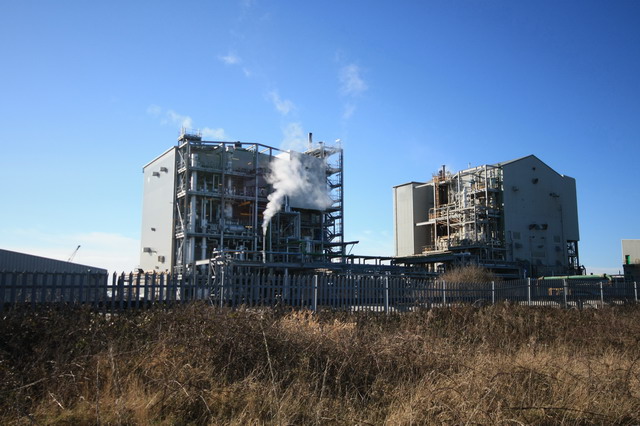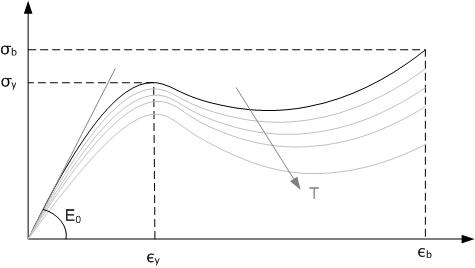|
PEEK
Polyether ether ketone (PEEK) is a beige coloured organic thermoplastic polymer in the polyaryletherketone (PAEK) family, used in engineering applications. It was invented in November 1978 and brought to market in the early 1980s by part of Imperial Chemical Industries (ICI), the PEEK division was acquired through a management buyout, giving rise to Victrex PLC. Synthesis PEEK polymers are obtained by step-growth polymerization by the dialkylation of bis phenolate salts. Typical is the reaction of 4,4'-difluorobenzophenone with the disodium salt of hydroquinone, which is generated in situ by deprotonation with sodium carbonate. The reaction is conducted around 300 °C in polar aprotic solvents - such as diphenyl sulfone. Properties PEEK is a semicrystalline thermoplastic with excellent mechanical and chemical resistance properties that are retained to high temperatures. The processing conditions used to mould PEEK can influence the crystallinity and hence the mec ... [...More Info...] [...Related Items...] OR: [Wikipedia] [Google] [Baidu] |
Victrex
Victrex plc is a United Kingdom, British-based supplier of high performance polymers. It is a constituent of the FTSE 250. The company's headquarters and manufacturing facilities are based in the UK with technical and customer support facilities in multiple markets, serving more than 40 countries. Victrex serves a diverse range of industries including aerospace, automotive, electronics, oil and gas and medical. History The company was established in 1993 by way of a management buyout of the ''PEEK'' polymer business of Imperial Chemical Industries plc. It was first listed on the London Stock Exchange in 1995. Based in Cleveleys near Blackpool in Lancashire Victrex has historically invested heavily to increase its capacity, most recently investing £90 million to increase production capacity by around 70%. By 2015 the production capacity of its polymer will be over 7,000 MT per annum (current capacity of 4,250 MT per annum). Operations The company is a manufacturer of high-perfor ... [...More Info...] [...Related Items...] OR: [Wikipedia] [Google] [Baidu] |
4,4'-Difluorobenzophenone
4,4’-Difluorobenzophenone is an organic compound with the formula of (FC6H4)2CO. This colorless solid is commonly used as a precursor to PEEK, or polyetherether ketone, a so-called high performance polymer. Because PEEK is resistant to attack, it is commonly used in carbon fiber coatings and cable insulation. Synthesis 4,4’-Difluorobenzophenone is prepared by the acylation of fluorobenzene with ''p''-fluorobenzoyl chloride. The conversion is typically conducted in the presence of an aluminium chloride catalyst in a petroleum ether solvent A solvent (from the Latin language, Latin ''wikt:solvo#Latin, solvō'', "loosen, untie, solve") is a substance that dissolves a solute, resulting in a Solution (chemistry), solution. A solvent is usually a liquid but can also be a solid, a gas .... :FC6H4C(O)Cl + C6H5F → (FC6H4)2CO + HCl Uses The polymer PEEK is generated from the reaction of 4,4'-difluorobenzophenone with the salts of 1,4-benzenediol.David Parker, Jan Bussink, Hend ... [...More Info...] [...Related Items...] OR: [Wikipedia] [Google] [Baidu] |
Polyaryletherketone
Polyaryletherketone (PAEK) is a family of semi-crystalline thermoplastics with high-temperature stability and high mechanical strength whose molecular backbone contains alternately ketone (R-CO-R) and ether groups (R-O-R). The linking group R between the functional groups consists of a 1,4-substituted aryl group.. Properties PAEK has a continuous operating temperature of and under short-term loads can function up to . When burned it has the least toxic and corrosive fumes. It also has a low heat output when burned, so it qualifies for use in interior aviation applications. It also has good overall chemical resistance.. It has a tensile strength of and a Young's modulus of . Its yield strength is at and at . It does not break in an un-notched Izod impact test.. Chemistry PAEK plastics are characterized by phenylene rings that are linked via oxygen bridges (ether and carbonyl groups (ketone)). The ratio and sequence of ether to ketones mainly affects the glass transition temp ... [...More Info...] [...Related Items...] OR: [Wikipedia] [Google] [Baidu] |
Hydroquinone
Hydroquinone, also known as benzene-1,4-diol or quinol, is an aromatic organic compound that is a type of phenol, a derivative of benzene, having the chemical formula C6H4(OH)2. It has two hydroxyl groups bonded to a benzene ring in a ''para'' position. It is a white granular solid. Substituted derivatives of this parent compound are also referred to as hydroquinones. The name "hydroquinone" was coined by Friedrich Wöhler in 1843. In 2022, it was the 268th most commonly prescribed medication in the United States, with more than 900,000 prescriptions. Production Hydroquinone is produced industrially in two main ways.Phillip M. Hudnall "Hydroquinone" in Ullmann's Encyclopedia of Industrial Chemistry 2002, Wiley-VCH, Weinheim. 2005 Wiley-VCH, Weinheim. . * The most widely used route is similar to the cumene process in reaction mechanism and involves the dialkylation of benzene with propene to give 1,4-diisopropylbenzene. This compound reacts with air to afford the bis(hydrop ... [...More Info...] [...Related Items...] OR: [Wikipedia] [Google] [Baidu] |
Diphenyl Sulfone
Diphenyl sulfone is an organosulfur compound with the formula (C6H5)2SO2. It is a white solid that is soluble in organic solvents. It is used as a high temperature solvent. Such high temperature solvents are useful for processing highly rigid polymers, e.g., PEEK, which only dissolve in very hot solvents. It is produced by the sulfonation of benzene with sulfuric acid and oleum. For typical processes, benzenesulfonic acid is an intermediate. It is also produced from benzenesulfonyl chloride Benzenesulfonyl chloride is an organosulfur compound with the formula C6H5SO2Cl. It is a colourless viscous oil that dissolves in organic solvents, but reacts with compounds containing reactive N-H and O-H bonds. It is mainly used to prepare sulfo ... and benzene. References Benzosulfones Phenyl compounds {{organic-compound-stub ... [...More Info...] [...Related Items...] OR: [Wikipedia] [Google] [Baidu] |
Imperial Chemical Industries
Imperial Chemical Industries (ICI) was a British Chemical industry, chemical company. It was, for much of its history, the largest manufacturer in Britain. Its headquarters were at Millbank in London. ICI was listed on the London Stock Exchange and was a constituent of the FT 30 and later the FTSE 100 Index, FTSE 100 indices. ICI was formed in 1926 as a result of the merger of four of Britain's leading chemical companies. From the onset, it was involved in the production of various chemicals, explosives, fertilisers, insecticides, dyestuffs, non-ferrous metals, and paints; the firm soon become involved in plastics and a variety of speciality products, including food ingredients, polymers, electronic materials, fragrances and flavourings. During the Second World War, ICI's subsidiary Nobel Enterprises, ICI Nobel produced munitions for Britain's war effort; the wider company was also involved with Britain's nuclear weapons programme codenamed Tube Alloys. Throughout the 1940s and ... [...More Info...] [...Related Items...] OR: [Wikipedia] [Google] [Baidu] |
Thermoplastic
A thermoplastic, or thermosoftening plastic, is any plastic polymer material that becomes pliable or moldable at a certain elevated temperature and solidifies upon cooling. Most thermoplastics have a high molecular weight. The polymer chains associate by intermolecular forces, which weaken rapidly with increased temperature, yielding a viscous liquid. In this state, thermoplastics may be reshaped, and are typically used to produce parts by various polymer processing techniques such as injection molding, compression molding, calendering, and extrusion. Thermoplastics differ from thermosetting polymers (or "thermosets"), which form irreversible chemical bonds during the curing process. Thermosets do not melt when heated, but typically decompose and do not reform upon cooling. Above its glass transition temperature and below its melting point, the physical properties of a thermoplastic change drastically without an associated phase change. Some thermoplastics do not fully ... [...More Info...] [...Related Items...] OR: [Wikipedia] [Google] [Baidu] |
Lewis Acid
A Lewis acid (named for the American physical chemist Gilbert N. Lewis) is a chemical species that contains an empty orbital which is capable of accepting an electron pair from a Lewis base to form a Lewis adduct. A Lewis base, then, is any species that has a filled orbital containing an electron pair which is not involved in bonding but may form a dative bond with a Lewis acid to form a Lewis adduct. For example, NH3 is a Lewis base, because it can donate its lone pair of electrons. Trimethylborane CH3)3Bis a Lewis acid as it is capable of accepting a lone pair. In a Lewis adduct, the Lewis acid and base share an electron pair furnished by the Lewis base, forming a dative bond. In the context of a specific chemical reaction between NH3 and Me3B, a lone pair from NH3 will form a dative bond with the empty orbital of Me3B to form an adduct NH3•BMe3. The terminology refers to the contributions of Gilbert N. Lewis. From p. 142: "We are inclined to think of substances as ... [...More Info...] [...Related Items...] OR: [Wikipedia] [Google] [Baidu] |
Bearing (mechanical)
A ball bearing A bearing is a machine element that constrains relative motion to only the desired motion and reduces friction between moving parts. The design of the bearing may, for example, provide for free linear movement of the moving part or for free rotation around a fixed axis; or, it may prevent a motion by controlling the vectors of normal forces that bear on the moving parts. Most bearings facilitate the desired motion by minimizing friction. Bearings are classified broadly according to the type of operation, the motions allowed, or the directions of the loads (forces) applied to the parts. The term "bearing" is derived from the verb " to bear"; a bearing being a machine element that allows one part to bear (i.e., to support) another. The simplest bearings are bearing surfaces, cut or formed into a part, with varying degrees of control over the form, size, roughness, and location of the surface. Other bearings are separate devices installed into a machine or mach ... [...More Info...] [...Related Items...] OR: [Wikipedia] [Google] [Baidu] |




